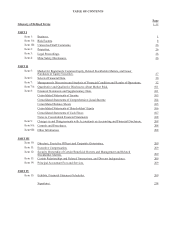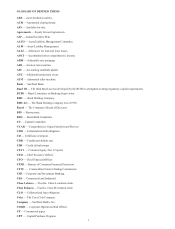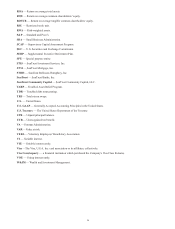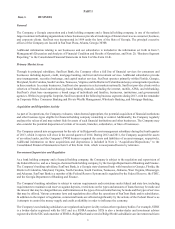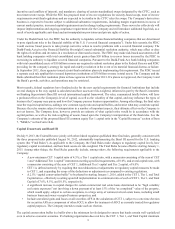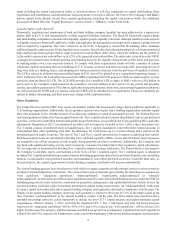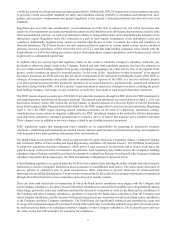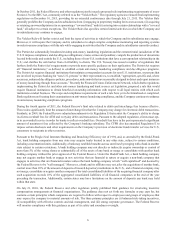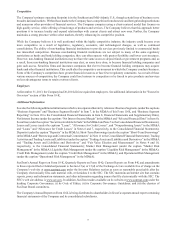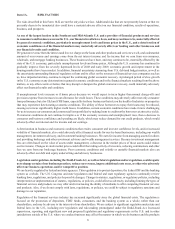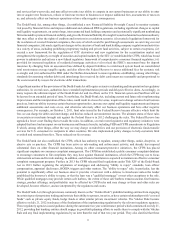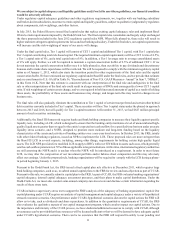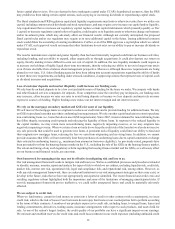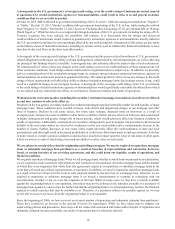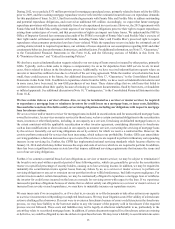SunTrust 2013 Annual Report Download - page 22
Download and view the complete annual report
Please find page 22 of the 2013 SunTrust annual report below. You can navigate through the pages in the report by either clicking on the pages listed below, or by using the keyword search tool below to find specific information within the annual report.6
In October 2011, the Federal Reserve and other regulators jointly issued a proposed rule implementing requirements of a new
Section 13 to the BHC Act, commonly referred to as the “Volcker Rule.” The regulatory agencies released final implementing
regulations on December 10, 2013, providing for an extended conformance date through July 21, 2015. The Volcker Rule
generally prohibits the Company and its subsidiaries from (i) engaging in proprietary trading for its own account, (ii) acquiring
or retaining an ownership interest in or sponsoring a “covered fund,” and (iii) entering into certain relationships with a “covered
fund,” all subject to certain exceptions. The Volcker Rule also specifies certain limited activities in which the Company and
its subsidiaries may continue to engage.
The Volcker Rule will further restrict and limit the types of activities in which the Company and its subsidiaries may engage.
Moreover, it will require the Company and its subsidiaries to adopt complex compliance monitoring and reporting systems
in order to assure compliance with the rule while engaging in activities that the Company and its subsidiaries currently conduct.
The Patriot Act substantially broadened existing anti-money laundering legislation and the extraterritorial jurisdiction of the
U.S. It imposes compliance and due diligence obligations; creates crimes and penalties; compels the production of documents
located both inside and outside the U.S., including those of non-U.S. institutions that have a correspondent relationship in the
U.S.; and clarifies the safe harbor from civil liability to clients. The U.S. Treasury has issued a number of regulations that
further clarify the Patriot Act's requirements or provide more specific guidance on their application. The Patriot Act requires
all “financial institutions,” as defined, to establish certain anti-money laundering compliance and due diligence programs.
The Patriot Act requires financial institutions that maintain correspondent accounts for non-U.S. institutions, or persons that
are involved in private banking for “non-U.S. persons” or their representatives, to establish, “appropriate, specific and, where
necessary, enhanced due diligence policies, procedures, and controls that are reasonably designed to detect and report instances
of money laundering through those accounts.” Recently the Financial Crimes Enforcement Network, which drafts regulations
implementing the Patriot Act and other anti-money laundering and bank secrecy act legislation, proposed a rule that would
require financial institutions to obtain beneficial ownership information with respect to all legal entities with which such
institutions conduct business. The scope and compliance requirements of such a rule have yet to be formalized or completed.
Bank regulators are focusing their examinations on anti-money laundering compliance, and the Company continues to enhance
its anti-money laundering compliance programs.
During the fourth quarter of 2011, the Federal Reserve's final rules related to debit card interchange fees became effective.
These rules significantly limit the amount of interchange fees that the Company may charge for electronic debit transactions.
Similarly, in 2009, the Federal Reserve adopted amendments to its Regulation E that restrict the Company's ability to charge
its clients overdraft fees for ATM and everyday debit card transactions. Pursuant to the adopted regulation, clients must opt-
in to an overdraft service in order for banks to collect overdraft fees. Overdraft fees have in the past represented a significant
amount of noninterest fees collected by the Company's banking subsidiary. The CFPB also has amended Regulation E to
impose certain disclosure and other requirements on the Company’s provision of electronic funds transfer services for U.S.
consumers to recipients in other countries.
Pursuant to the Riegle-Neal Interstate Banking and Branching Efficiency Act of 1994, and, as amended by the Dodd-Frank
Act, bank holding companies from any state may acquire banks located in any other state, subject to certain conditions,
including concentration limits. Additionally, a bank may establish branches across state lines by merging with a bank in another
state subject to certain restrictions. A bank holding company may not directly or indirectly acquire ownership or control of
more than 5% of the voting shares or substantially all of the assets of any bank or merge or consolidate with another bank
holding company without the prior approval of the Federal Reserve. Under the Dodd-Frank Act, a bank holding company
may not acquire another bank or engage in new activities that are financial in nature or acquire a non-bank company that
engages in activities that are financial in nature unless the bank holding company is both "well capitalized" and deemed by
the Federal Reserve to be "well managed." Moreover, a bank and its affiliates may not, after the acquisition of another bank,
control more than 10% of the amount of deposits of insured depository institutions in the U.S., and a financial company may
not merge, consolidate or acquire another company if the total consolidated liabilities of the acquiring financial company after
such acquisition exceeds 10% of the aggregated consolidated liabilities of all financial companies at the end of the year
preceding the transaction. Additionally, certain states may have limitations on the amount of deposits any bank may hold
within that state.
On July 21, 2010, the Federal Reserve and other regulators jointly published final guidance for structuring incentive
compensation arrangements at financial organizations. The guidance does not set forth any formulas or pay caps for, but
contains certain principles which companies are required to follow with respect to employees and groups of employees that
may expose the company to material amounts of risk. The three primary principles are (i) balanced risk-taking incentives,
(ii) compatibility with effective controls and risk management, and (iii) strong corporate governance. The Federal Reserve
will monitor compliance with this guidance as part of its safety and soundness oversight.


